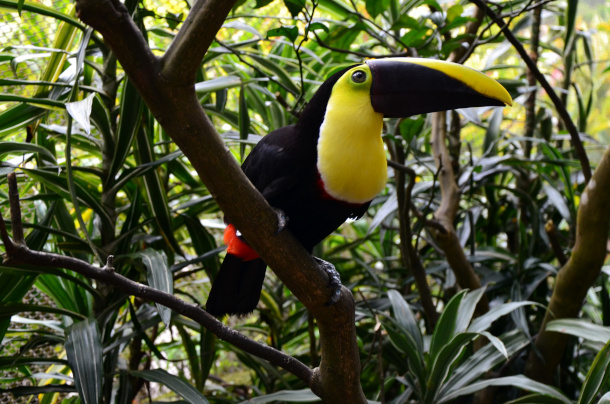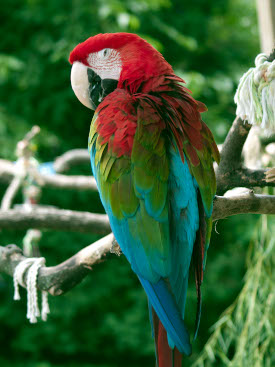Forests of Rain
Air Date: Week of August 14, 2020

The chestnut-mandibled toucan is often found in lowland forests and close to major bodies of water in Central and South America. (Photo: Tony Fernandez, Flickr, CC BY NC 2.0)
In the rainforests of Costa Rica, Living on Earth’s Explorer in Residence Mark Seth Lender encounters a chestnut-mandibled toucan and a scarlet macaw while traveling through the Osa Peninsula.
Transcript
BASCOMB: Rainforests circle the earth like a green belt around the equator. So, from Borneo we take you now to the other side of the planet to a Rainforest in Costa Rica with Living on Earth’s Explorer in Residence Mark Seth Lender.
Forests of Rain
Parque Nacional Corcovado
Costa Rica
© 2020 Mark Seth Lender
All Rights Reserved
On the Osa Peninsula, before the hotels and the money found out, you could walk the edges longer than your drinking water would hold out and never see a human being. It was just Valerie, me, Alonso in the lead pointing out all we would have missed.
“Gavilan Cangrejero,” crab hawk.
“Snake. He imitates, El Fer de Lance.” I bend down -
!No!” Alonso touches my arm. “He might be the real thing.”
That morning at sunrise we woke to Scarlet Macaws, flying rainbows flight after raucous flight. We followed on the beach but they were gone. Now, so is the sun. Under muddy clouds we reach the Madrigal, hardly a trickle of water between the few yards from rainforest on one side, to the Pacific on the other.
Alonso looks up, looks at the river, clicks his tongue. “Si crescenda el Madrigal…”
We cross anyway and continue.
From behind comes a large man with a woven basket. He and Alonso nod. The man looks us over, strides on. “El Pescador,” Alonso says, fisherman. Later we learn what the basket was for: Turtle eggs. Olive Ridley, Hawksbill, Green, all of them nest here. El Pescador has emptied every nest. To him not food but money, he will sell every single one.

The Scarlet Macaw is a parrot from Central and South American that’s most often found in pairs or small family groups. (Photo: David Ellis, Flickr, CC BY NC ND 2.0)
The sky goes black; now, in earnest, rain.
We turn around.
The Madrigal has become the physical translation of crescenda. There are standing waves three feet high in only four vertical feet of water. Enough to sweep a giant off his feet into the crashing sea to drown. Except –
El Pescador has tied a thick line across the river between two trees and left it, for us.
Valerie cannot touch bottom, the current is too strong. Her arms close around my chest and I pull us hand over hand. It takes all I have...
Next morning the sun rises hot and bright as if it forgot. Look, Valerie says. Among tiny purple orchids in the notch of the tree is a Chestnut-mandibled Toucan. High in the canopy, howler monkeys call like Buddhist monks chanting deep in the throat and are answered, by distant thunder.
RAAAAAHHHHHhhhhhhh...
BASCOMB: That’s Living on Earth’s Explorer in Residence, Mark Seth Lender.
Links
Living on Earth wants to hear from you!
Living on Earth
62 Calef Highway, Suite 212
Lee, NH 03861
Telephone: 617-287-4121
E-mail: comments@loe.org
Newsletter [Click here]
Donate to Living on Earth!
Living on Earth is an independent media program and relies entirely on contributions from listeners and institutions supporting public service. Please donate now to preserve an independent environmental voice.
NewsletterLiving on Earth offers a weekly delivery of the show's rundown to your mailbox. Sign up for our newsletter today!
 Sailors For The Sea: Be the change you want to sea.
Sailors For The Sea: Be the change you want to sea.
 The Grantham Foundation for the Protection of the Environment: Committed to protecting and improving the health of the global environment.
The Grantham Foundation for the Protection of the Environment: Committed to protecting and improving the health of the global environment.
 Contribute to Living on Earth and receive, as our gift to you, an archival print of one of Mark Seth Lender's extraordinary wildlife photographs. Follow the link to see Mark's current collection of photographs.
Contribute to Living on Earth and receive, as our gift to you, an archival print of one of Mark Seth Lender's extraordinary wildlife photographs. Follow the link to see Mark's current collection of photographs.
 Buy a signed copy of Mark Seth Lender's book Smeagull the Seagull & support Living on Earth
Buy a signed copy of Mark Seth Lender's book Smeagull the Seagull & support Living on Earth

